How to Attach a Wooden Trellis? A Step-by-Step Guide for Gardeners

A wooden trellis can be a beautiful and functional addition to any garden, providing support for climbing plants while enhancing the overall aesthetic. However, attaching a trellis securely is essential to ensure it withstands the elements and provides the necessary support for your greenery. In this step-by-step guide, we will explore the tools, materials, and techniques you need to effectively attach a wooden trellis, regardless of your gardening experience. Whether you’re looking to beautify your garden or improve plant health, follow these straightforward instructions to achieve a sturdy and visually appealing trellis installation.
How to Properly Attach a Wooden Trellis
Attaching a wooden trellis can enhance the aesthetics of your garden while providing support for climbing plants. To ensure a secure installation, start by selecting the right location, ideally where the trellis can receive adequate sunlight and support plant growth. Use a level to ensure the trellis is upright, and then anchor it to a sturdy structure or wall with screws or brackets. If installing directly into the ground, you may need to dig post holes and set the trellis in concrete for added stability. Properly measuring and aligning your trellis will help prevent future leaning or falling.
Choosing the Right Location
When selecting a location for your wooden trellis, consider factors such as sunlight exposure, visibility, and proximity to plants that will climb it. A spot that receives full sunlight for most of the day is ideal for many climbing plants. Additionally, placing the trellis where it can be easily seen from your home or garden path will enhance its visual appeal. Ensure there is enough space around it for growth, as well as access for maintenance and care.
Tools and Materials Needed
Before you begin the installation, gather essential tools and materials to ensure a smooth process. You'll need a level, drill, screws or brackets, a saw if you're cutting wood, measuring tape, and possibly concrete mix if you're setting the trellis in the ground. Having all of your materials on hand before starting will save you time and help prevent interruptions during the installation process.
Preparing the Ground or Wall
If you're attaching the trellis to a wall, ensure the surface is clean and free of debris, as this will promote a sturdy connection. For ground installations, check for large rocks or roots that may obstruct post holes. You may need to dig down at least 2 feet to properly secure the posts in soil or concrete. The deeper the posts, the more stable your trellis will be in the long term.
Securing the Trellis
When you’re ready to secure your trellis, use a level to ensure it is perpendicular to the ground, preventing any future lean. If attaching to a wall, use wood screws or brackets to firmly hold the trellis in place. In the case of a ground installation, mix and pour concrete into the holes around the posts for added stability. Allow the concrete to set for at least 24 hours before adding any plants to the trellis.
Maintenance Tips
Regular maintenance is essential for the longevity of your wooden trellis. Check for signs of rot or damage periodically and replace any dilapidated sections promptly. Additionally, consider applying a weather-resistant wood stain or sealant to protect against moisture and insects. Pruning any climbing plants regularly will also prevent excess weight that could threaten the integrity of the trellis.
| Aspect | Description |
|---|---|
| Location | Choose a sunny, visible spot. |
| Tools | Level, drill, screws, saw, measuring tape. |
| Ground Prep | Clear debris, dig deep holes. |
| Securing Method | Use screws/brackets or concrete. |
| Maintenance | Check for rot, apply sealant. |
How do you anchor a wooden trellis?
To properly anchor a wooden trellis, you need to ensure stability and support, especially if it will bear the weight of climbing plants. Here are the steps to effectively anchor your trellis:
1. Choose the Right Location: Select a spot that provides adequate sunlight and accessibility for the plants that the trellis will support. Make sure the ground is level and firm.
2. Select Proper Materials: Use treated wood or rot-resistant materials for durability. The anchoring method may vary based on the size of the trellis.
3. Secure the Trellis:
- Dig Holes: For a freestanding trellis, dig holes approximately 2 feet deep for the posts, depending on the height of the trellis and local climate conditions.
- Insert Posts: Place the trellis posts into the holes and ensure they are vertical using a level.
- Backfill: Fill the holes with soil or concrete mix for stability, ensuring the posts remain straight as the material settles.
4. Add Supports: When necessary, add braces or supports to enhance stability, especially for larger trellises.
5. Check for Stability: After installation, test the stability of the trellis by applying gentle pressure to ensure it does not wobble.
Determine the Best Anchoring Method
Choosing the appropriate method to anchor your wooden trellis is vital for its longevity and effectiveness. Here are a few common methods:
- Concrete Footings: Pouring concrete around the base of the posts provides a solid foundation.
- Ground Anchors: Use heavy-duty ground anchors for softer soil.
- Stakes and Guy Wires: Install stakes and use guy wires for extra support, especially for taller structures.
Materials Needed for Anchoring
Before you begin anchoring the trellis, gather all the necessary materials to ensure a smooth process. Key materials include:
- Wood Posts: Sufficient support for the trellis structure.
- Concrete or Gravel: For setting the posts in place.
- Hardware Supplies: Screws, brackets, and, if needed, ropes or wires for additional support.
Maintenance Tips for Anchored Trellises
Keeping your wooden trellis secure and stable requires regular maintenance. Follow these tips:
- Inspect Regularly: Check for any signs of wear, damage, or instability.
- Reinforce as Needed: Add resources like guy wires or additional concrete if the trellis shows signs of leaning.
- Maintain Plant Growth: Prune and train climbing plants to avoid excessive weight on the trellis.
Seasonal Considerations for Trellis Anchoring
Different seasons can affect the stability of your trellis. Pay attention to these seasonal factors:
- Winter Conditions: Snow and ice can add extra weight; reinforce trellis supports beforehand.
- Heavy Rains: Ensure drainage around the base to prevent erosion.
- Summer Wind: Monitor any high winds and assess if additional anchoring is needed.
Customizing Your Trellis Design for Anchoring
Enhance the functionality of your trellis by customizing its design while considering anchoring:
- Size and Shape: Choose a size that complements your garden but also requires adequate anchoring.
- Material Choices: Consider using different materials that offer various benefits for stability and aesthetics.
- Integrated Supports: Design the trellis with built-in support angles or braces to aid anchoring efforts.
How do you secure a wooden trellis?
To secure a wooden trellis, several methods can be employed depending on its intended use and the environment it's placed in. The following steps outline how to effectively secure a wooden trellis, ensuring it remains stable and functional for your gardening or aesthetics purposes.
Choosing the Right Location
Selecting an appropriate location is crucial for the stability and effectiveness of the wooden trellis. Consider:
- Sunlight: Ensure the trellis is placed in a spot that receives adequate sunlight for the plants you intend to support.
- Wind Protection: Identify areas that are shielded from strong winds which can easily topple a trellis.
- Accessibility: Make sure it’s easily accessible for maintenance and harvesting if you are growing climbing plants.
Using Support Posts
Incorporating support posts is one of the best ways to secure a wooden trellis. This method enhances stability and durability. The steps include:
- Post Material: Choose sturdy materials like treated wood, metal, or PVC to ensure longevity.
- Depth of Posts: Dig holes at least 2 feet deep for the posts, ensuring they are anchored firmly.
- Concrete Setting: For additional strength, consider setting the posts in concrete to maintain stability against elements.
Anchoring to Walls or Fences
If the trellis is near a wall or fence, anchoring it can provide extra support. This is how to do it effectively:
See also: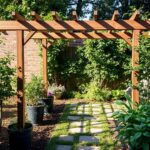 Can a Trellis Be Free Standing? Exploring the Benefits and Design Ideas
Can a Trellis Be Free Standing? Exploring the Benefits and Design Ideas- Wall Brackets: Use sturdy brackets to attach the trellis securely to the wall.
- Spacing: Ensure that there is adequate space between the wall and the trellis for air circulation and plant growth.
- Rust-resistant Fasteners: Always use rust-resistant screws or ties to prevent deterioration of materials over time.
Using Ground Anchors
Ground anchors are an effective solution for securing trellises, especially in open areas. Consider the following:
- Type of Anchor: Select heavy-duty ground anchors suitable for the size and weight of your trellis.
- Installation: Drive the anchors into the ground at an angle towards the trellis for maximum support.
- Tensioning Cables: If necessary, use tensioning cables connected to the anchors to provide additional support against winds.
Regular Maintenance Checks
Consistent maintenance helps prolong the life and stability of your wooden trellis. Conduct regular checks including:
- Inspect for Damage: Look for signs of rot or insect damage, especially at the base of the trellis.
- Reinforce Connections: Tighten any loose connections or damaged brackets to reinforce the structure.
- Refresh Wood Treatments: Apply protective coatings or stains every few years to prevent deterioration caused by weather conditions.
How do you support a freestanding trellis?

To support a freestanding trellis, it is essential to ensure that it is stable and can withstand various environmental conditions. Here are several effective methods to do this:
1. Use of Heavy Base Plates: Attaching heavy base plates to the bottom of the trellis can provide a sturdy foundation. These plates can be made from materials such as concrete or metal. The weight helps prevent the trellis from tipping over in adverse weather conditions.
2. Incorporate Guy Wires: Installing guy wires can significantly enhance the stability of a freestanding trellis. These are tensioned cables that anchor the trellis to the ground or surrounding structures, providing additional support against wind.
3. Plant Growth: Utilizing climbing plants can also add an element of stability to the trellis. As plants grow and intertwine with the trellis, they generate inherent weight and support, which helps keep the structure upright.
4. Burying Posts: For a more permanent solution, consider partially burying the trellis posts into the ground. This method provides a natural anchor and reduces the likelihood of the trellis being knocked over.
5. Secure Anchoring Systems: Utilizing anchor systems like stakes or brackets can provide further reinforcement. These systems can be attached to the base of the trellis and secured into the ground, ensuring stability even during storms or high winds.
Heavy Base Plates
Using heavy base plates is one of the most effective ways to stabilize a freestanding trellis. When applying this method, consider the following:
- Choose materials such as concrete or steel for weight and durability.
- Attach the base plates securely to the bottom of the trellis posts.
- Ensure that the plates are wide enough to distribute the weight evenly.
Guy Wires for Support
Guy wires are an essential tool for adding additional support to a freestanding trellis. To use them effectively:
- Identify sturdy anchor points around the trellis for the wires to be secured.
- Attach the wires at a diagonal angle from the top of the trellis to the anchor points.
- Tighten the wires adequately to provide the necessary tension and support.
Incorporating Plants
Utilizing climbing plants can naturally support the trellis as they grow. Important considerations include:
- Select climbing species that are suitable for the climate and soil conditions.
- Train the plants to grow along the trellis as they mature.
- Regular maintenance, such as pruning, will ensure healthy growth and stability.
Burying Trellis Posts
Partially burying the trellis posts is a long-lasting solution for stability. Here’s how to do it:
- Dig holes deep enough to fit at least one-third of the post length underground.
- Ensure the hole is wider than the post for added stability.
- Backfill the hole with soil and compact it firmly around the post.
Anchor Systems
Using secure anchoring systems can enhance stability significantly. Follow these steps:
- Choose robust stakes or brackets designed for outdoor use.
- Attach them to the trellis base, making sure they are well-positioned.
- Drive the stakes deep into the ground for maximum hold.
How to attach wooden trellis to wall without drilling?
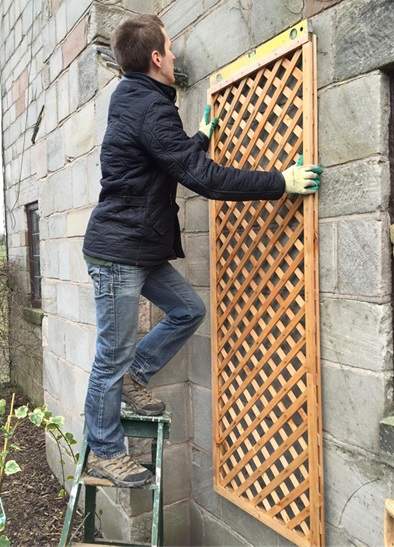
To attach a wooden trellis to a wall without drilling, you can use several effective methods that rely on adhesives, tension, or freestanding supports. Below are some approaches to consider:
Using Adhesive Hook and Loop Strips
One of the simplest ways to attach a wooden trellis without drilling is by using adhesive hook and loop strips. These strips provide a strong bond while allowing for easy removal if needed.
- Choose high-quality adhesive strips that are designed for outdoor use to ensure durability.
- Clean the wall surface thoroughly to remove dust and debris for better adhesion.
- Apply the hook and loop strips to the back of the trellis and press it against the wall, ensuring it's firmly in place.
Using Paintable Adhesive Caulk
Adhesive caulk can be a very effective method for attaching your wooden trellis without causing damage to the wall. This method provides a strong bond suitable for heavier trellises.
- Apply a bead of paintable adhesive caulk along the back edges of the trellis.
- Press the trellis firmly against the wall and hold it for a few moments to ensure a proper seal.
- Allow sufficient drying time as recommended by the caulk manufacturer before adding any weight to the trellis.
Using Wire or Twine
If your wooden trellis is lightweight, you can use wire or twine to secure it without drilling. This method involves tying the trellis to a stable structure or using existing hooks.
- Identify a stable anchor point on or near the wall, such as a fence, post, or another wall-mounted fixture.
- Use durable wire or twine to loop around the trellis and tie it securely to the anchor point.
- Adjust the tension to ensure the trellis remains straight and stable without tipping over.
Using Freestanding Supports
For those who want to avoid wall attachment entirely, a freestanding support system can be an excellent alternative. This permits easy relocation and installation without any wall modifications.
- Purchase or build a freestanding frame that can hold the trellis upright.
- Secure the trellis to the frame using small screws or brackets, which can easily be removed.
- Position the freestanding unit against the wall to achieve the desired aesthetic while remaining independently stable.
Using Clamps or Brackets
Clamps or brackets can offer a strong hold without the need for screws or drilling into the wall. They can be adjusted as needed while providing a reliable connection.
- Select appropriate clamps or brackets that match the size and weight of your trellis.
- Attach the brackets to the edge of the trellis according to the manufacturer's instructions.
- Using existing structures, secure the brackets to the wall surfaces, ensuring they are tight and stable.
Questions from Our Readers
How do I prepare the wall for attaching a wooden trellis?
To prepare the wall for attaching a wooden trellis, you should first clean the surface to remove any dirt or debris. If necessary, apply a protective coat to the wall to prevent moisture damage. Ensure that the wall is level and inspect it for any cracks or damages that may affect the stability of the trellis.
What tools do I need to attach a wooden trellis?
To attach a wooden trellis, you will typically need a drill, screws, and possibly anchors if you are mounting it on masonry. Additionally, having a level, measuring tape, and a saw may help in trimming the trellis to fit your desired space more accurately.
Can I attach a wooden trellis to a fence?
Yes, you can attach a wooden trellis to a fence as long as it is secure and sturdy enough to support the trellis. Make sure to use appropriate fasteners and consider the height of the trellis; it should not impede the privacy or structural integrity of the fence.
See also: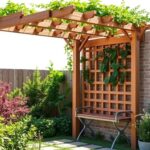
How high should I install the wooden trellis?
The height at which you install a wooden trellis depends on its intended use, but a general guideline is to install it at least two to three feet above the ground to prevent weeds from obstructing the plants. If it's for climbing plants, ensure it is high enough to provide ample support for their growth.

If you want to read more articles like How to Attach a Wooden Trellis? A Step-by-Step Guide for Gardeners, we recommend you check out our Trellis category.
Leave a Reply
Related Articles